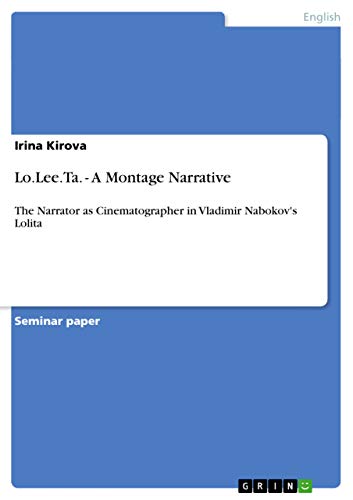Verwandte Artikel zu Lo.Lee.Ta. - A Montage Narrative: The Narrator as Cinematogr...
Lo.Lee.Ta. - A Montage Narrative: The Narrator as Cinematographer in Vladimir Nabokov's Lolita - Softcover

Zu dieser ISBN ist aktuell kein Angebot verfügbar.
Alle Exemplare der Ausgabe mit dieser ISBN anzeigen:„Über diesen Titel“ kann sich auf eine andere Ausgabe dieses Titels beziehen.
- VerlagGRIN Verlag
- Erscheinungsdatum2013
- ISBN 10 365635328X
- ISBN 13 9783656353287
- EinbandTapa blanda
- Auflage2
- Anzahl der Seiten36
Neu kaufen
Mehr zu diesem Angebot erfahren
Versand:
EUR 23,00
Von Deutschland nach USA
Beste Suchergebnisse bei AbeBooks
Lo.Lee.Ta. - A Montage Narrative
Buchbeschreibung Taschenbuch. Zustand: Neu. This item is printed on demand - it takes 3-4 days longer - Neuware -Seminar paper from the year 2012 in the subject English Language and Literature Studies - Literature, grade: 1,3, Humboldt-University of Berlin (Anglistik und Amerikanistik), course: HS Vladimir Nabokov, language: English, abstract: In an experiment, Russian film maker and film theorist Lev Kuleshov edited together a short film in which a shot of the actor Ivan Mosjoukine was combined with various other shots, among them a bowl of soup, a woman, and shot of a child in a coffin. The film was shown to an audience who believed the actor expressed different emotions with each situation, when in fact, the footage of Mosjoukine was the same shot repeated over and over again. Even though, Mosjoukine did not see the shots, and hence, could not react to either of them, the viewers were convinced to witness the adequate emotions. Thus, the viewer filled in the blanks and saw the expression, although there was none.The impact of this experiment was called the Kuleshov effect. It illustrates the significance of film editing as well as the importance of the viewer. The Kuleshov effect brings together the thought of the cinematographer and the idea the viewer creates in his own mind. The result of this co-production is a whole new meaning that can refer to something that was denoted before, but can also be unrelated to it.Vladimir Nabokov's Lolita manifests a lively dialogue between literature and cinema. But how and to what extent has montage philosophy influenced this work In the following paper, I aim to show that Humbert Humbert, the central character's presentation of the story appears in a cinematic manner as his first-person narrative makes use of various means of film technique. Moreover, his position towards people, particularly Lolita, bears resemblance to the relationship between a director and his actors. In other words, in Lolita, we follow the protagonist as he directs the story and the people around him. 36 pp. Englisch. Bestandsnummer des Verkäufers 9783656353287
Weitere Informationen zu diesem Verkäufer | Verkäufer kontaktieren
Lo.Lee.Ta. - A Montage Narrative : The Narrator as Cinematographer in Vladimir Nabokov's Lolita
Buchbeschreibung Taschenbuch. Zustand: Neu. Druck auf Anfrage Neuware - Printed after ordering - Seminar paper from the year 2012 in the subject English Language and Literature Studies - Literature, grade: 1,3, Humboldt-University of Berlin (Anglistik und Amerikanistik), course: HS Vladimir Nabokov, language: English, abstract: In an experiment, Russian film maker and film theorist Lev Kuleshov edited together a short film in which a shot of the actor Ivan Mosjoukine was combined with various other shots, among them a bowl of soup, a woman, and shot of a child in a coffin. The film was shown to an audience who believed the actor expressed different emotions with each situation, when in fact, the footage of Mosjoukine was the same shot repeated over and over again. Even though, Mosjoukine did not see the shots, and hence, could not react to either of them, the viewers were convinced to witness the adequate emotions. Thus, the viewer filled in the blanks and saw the expression, although there was none.The impact of this experiment was called the Kuleshov effect. It illustrates the significance of film editing as well as the importance of the viewer. The Kuleshov effect brings together the thought of the cinematographer and the idea the viewer creates in his own mind. The result of this co-production is a whole new meaning that can refer to something that was denoted before, but can also be unrelated to it.Vladimir Nabokov's Lolita manifests a lively dialogue between literature and cinema. But how and to what extent has montage philosophy influenced this work In the following paper, I aim to show that Humbert Humbert, the central character's presentation of the story appears in a cinematic manner as his first-person narrative makes use of various means of film technique. Moreover, his position towards people, particularly Lolita, bears resemblance to the relationship between a director and his actors. In other words, in Lolita, we follow the protagonist as he directs the story and the people around him. Bestandsnummer des Verkäufers 9783656353287
Weitere Informationen zu diesem Verkäufer | Verkäufer kontaktieren

